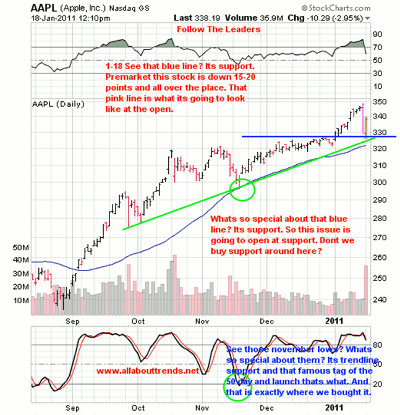Traders are probably familiar with the phrase, “Buy the dips and sell the rips.” I would probably qualify that axiom with “Buy the dips (as long as we are in an uptrend, as defined by being above the 50-day and trend channel support) and sell the rips (but only down to support and trend lines).”
Apple, Inc. (AAPL) recently provided a great example of how to trade this philosophy. On Tuesday (Jan. 18), Apple opened down 4%-5% because of the Steve Jobs health issue news.
Can anyone guess where that took the stock? If you said support, then you are correct. Check out the chart below:
Notice where AAPL opened up and stopped? It isn’t a coincidence that it stopped just short of the recent trend line extending all the way back to late-September 2010. The 50-day moving average (blue line) also provided support in that area. The more we can stack up under a stock (moving averages, trend lines, etc.), the more likely it is to reverse in that area.
If you are one who owned Apple and allowed your emotions to get the best of you after it already got slammed while the markets were closed on Monday (think damage already done) and sold on the open, well then, Apple took a bite out of you.
If you are one who buys the dips in issues that are in clearly defined uptrends above the 50-day average and at trend channel support and in the face of fear and panic, then you took a bite out of it.
AAPL promptly bounced from support at $327 on Tuesday and then popped Wednesday morning (to $347) following its earnings report. The opportunistic trader—who understands that when a leading stock gets slammed to support, it’s a buying opportunity—is the trader who got paid.
This is what the face of fear is all about. This is why we use support and resistance. This is why we let our stocks tell us what to do by the actions they exhibit at key turning points. These key turning points being support, news driven or not vs. trading by the seat of your pants from an emotional standpoint. Your emotions either control you or you control them.
By David Grandey of All About Trends


















